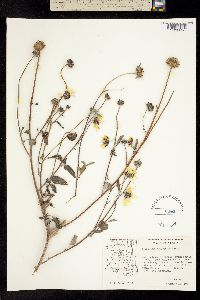Helianthus petiolaris
|
|
|
|
Family: Asteraceae
Prairie Sunflower, more... (es: girasol)
|
Annuals, 40-200 cm. Stems erect, usually densely canescent, hispid, or strigillose, rarely ± hirsute or glabrate. Leaves mostly cauline; mostly alternate; petioles 2-4 cm; blades (often bluish green) lanceolate to deltate-ovate or ovate, 4-15 × 1-8 cm, bases subcordate or truncate to cuneate, margins entire or ± serrate, abaxial faces strigose, sparsely to densely, or not at all, gland-dotted. Heads 1-5. Peduncles 4-15(-40) cm. Involucres ± hemispheric, 10-24 mm diam. Phyllaries 14-25, lance-linear to lanceolate to lance-ovate, 10-14 × 1-4(-5) mm, (margins sometimes ciliate) apices short-attenuate, abaxial faces usually hispidulous, rarely sparsely hirsute to glabrate. Paleae 4.5-7.5 mm, 3-toothed, middle teeth ± ciliate or bearded, hairs whitish, 0.5-0.7 mm. Ray florets 10-30; laminae 15-20 mm. Disc florets 50-100+; corollas 4.5-6 mm, lobes usually reddish, rarely yellow; anthers reddish to purplish, appendages purplish (style branches reddish). Cypselae 3-4.5 mm, ± villous; pappi of 2 aristate scales 1.5-3 mm plus 0-2 erose scales 0.3-0.5 mm. 2n = 34. Helianthus petiolaris is adventive beyond western North America. A third subspecies has yet to be named at that rank in Helianthus petiolaris; it has been called H. petiolaris var. canescens A. Gray. It differs in having stems, leaves, and phyllaries densely canescent and abaxial faces of leaves densely gland-dotted. It is additionally characterized by peduncles usually ebracteate, phyllaries 1-2 mm wide, disc corolla throats gradually narrowed distal to slight, not densely hairy basal bulges, and 2n = 34. It flowers late spring through late summer and grows on sandy soils in open areas at (10-)1000-2300 m in Arizona, California, Nevada, New Mexico, and Texas and in Mexico. It was treated as H. niveus (Bentham) Brandegee subsp. canescens (A. Gray) Heiser by C. B. Heiser et al. (1969); molecular and morphologic data appear to favor a placement within H. petiolaris.
FNA 2006, Wiggins 1964, Kearney and Peebles 1969, Allred and Ivey 2012, Heil et al 2013. Duration: Annual Nativity: Native Lifeform: Forb/Herb General: Annual herbs, 30-100 cm tall, from a taproot; stems erect, usually branched distally, scaberulous and distinctly green. Leaves: Lower leaves opposite and upper leaves alternate; on slender hispid petioles, 1-5 cm long; blades narrowly lanceolate to ovate-lanceolate with wedge-shaped bases and pointed tips, 3-8 cm long and 0.5 to 3 cm wide, the upper blade surfaces scaberulous and dark green and lower surfaces paler and more densely pubescent, the margins entire to serrate or sinuate-serrate. Flowers: Flower heads large, showy and radiate, yellow with dark centers, on slender peduncles to 15 cm long, these densely puberulent just beneath the flower heads; involucres hemispheric, 1-2 cm wide, the bracts (phyllaries) lanceolate to lance-ovate with slightly acuminate tips, 6-10 mm long, equaling or barely surpassing disk corollas, scaberulous; ray florets 7-15 per flower head, the laminae (ray petals) yellow, 2 cm long; disc florets 50-100 of more per flower head, reddish-purple. Fruits: Achenes 3-5 mm long, striate and faintly mottled, sparsely silky-puberulent below, more densely so above; topped with a pappus of 2 lanceolate scales, 2-3 mm long. Ecology: Found on hillsides and valley floors from 500-7,500 ft (152-2286 m); flowers March-October. Distribution: Native to central and western N. America, adventive eastward and now found throughout most of the US and s CAN. Notes: H. petiolaris is very similar to H. annuus but smaller and more slender in all respects, with phyllaries that are lanceolate and usually not ciliate-margined, and the central receptacle scales conspicuously white-bearded at the tip. Three varieties are recognized in New Mexico: var. canescens is uncommon and has leaves that are white-tomentose on both surfaces; var. fallax has red anthers and a single leaf-like bract subtending the flower head; var. petiolaris has purple anthers and lacks the subtending bract. Ethnobotany: Used as a spider bite medicine by the Hopi, for good luck in hunting when flower infusion is sprinkled on clothing, as life medicine, and as an ointment on sores and swellings. The seeds were saved and eaten, and sometimes ground as meal. Flower petals were mixed with corn meal for ceremonial powder. Etymology: Helianthus is from the Greek helios, sun and anthos, flower; petiolaris means with conspicuous petioles. Synonyms: None Editor: SBuckley 2010, AHazelton 2017 Similar to H. annuus, but smaller, seldom over 1 m, with narrower, more often entire, rarely cordate lvs, which may be more densely hairy beneath, and with smaller heads, the disk 1-2.5 cm wide; invol bracts lanceolate or lance-ovate, tapering gradually to the tip, shortly scabrous-hispid, seldom at all ciliate or with any long hairs; central receptacular bracts conspicuously white- bearded at the tip; 2n=34. Prairies, plains, and waste places, especially in sandy soil; native mainly on the Great Plains and in sw. U.S., but occasionally eastward as a weed. June-Sept. Ours is var. petiolaris Gleason, Henry A. & Cronquist, Arthur J. 1991. Manual of vascular plants of northeastern United States and adjacent Canada. lxxv + 910 pp. ©The New York Botanical Garden. All rights reserved. Used by permission. |
|
|
|































































































